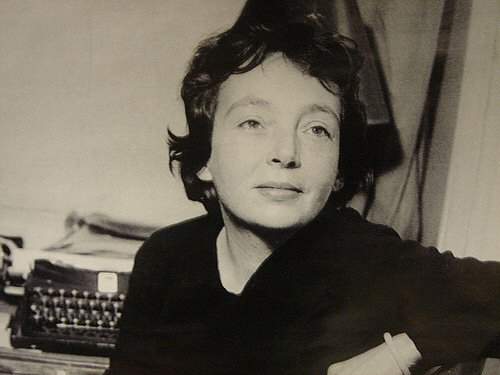|
La Chambre Des Reines
|
Other Art - Writers
|
(1914 - 1996)
"Ecrire,
c'est aussi ne pas parler. C'est se taire. C'est hurler sans bruit."
France's most celebrated woman writer of the late 20th c. Duras’ reputation is largely uncontested today: any history
of French artistic and intellectual life in the 1950s and 60s accords her a
significant place. She produced over 70 novels, plays, and films. Moving
constantly beyond the various schools and movements with which critics have
associated her, creating texts which increasingly abolish the boundaries between
novel, film, and play, her work pushes formal constraints to their limits and
defies any easy classification. Many of her novels have been made into films and most of which deal unsentimentally with love, despair, and sexual passion. * They include: Un Barrage contre le Pacifique - The Sea Wall, Moderato Cantabile, La Ravissement de Lol V. Stein - The Ravishing of Lol Stein, La vie materielle - Practicalities and La Douleur - The War: A Memoir. * Her mysterious and sensual semi-autobiographical novel L'Amant - The Lover, an international bestseller, was her first work of fiction to reach a large popular audience. * In the 1950s Duras was approached to write a film scenario: Hiroshima (mon amour) (1959, directed by Alain Resnais) was a great success and was to open up new directions in her work. Overcoming a sordid and humiliating childhood in French Indo-China, Duras - whose real name was Marguerite Donnadieu, grew up in what's now called Vietnam, except for two years which she spent at a family home near the town of Duras in southwestern France, where her father's house was located. Her father, a math teacher, died when she was four.
After his death, her mother, a teacher, remained in Indochina with her three children. The family lived in relative poverty after a bad investment in an isolated property and area of farmland in Cambodia. The difficult life that the family experienced during this period was highly influential on Marguerite's later work. Encouraged by her mother, Duras embarked on a romantic and sexual liaison with a wealthy Asian man. One of Duras' biographers, Laure Adler, asserted in "Marguerite Duras: A life", that Duras was essentially sold into prostitution by her mother in order to finance the drug habit of her brother Pierre, but this has been strongly disputed by her son, Jean Mascolo. Both the affair and the family battle with the encroaching ocean would recur as motifs in Duras' writing.
She moved alone to Paris to study at the Sorbonne, from which she received licences in law and politics, associated with left-wing students and met her future husband, the philosopher Robert Antelme and her second husband, Dionys Mascolo. Shortly after the outbreak of war Duras married Robert Antelme, at a civil ceremony in which, as her husband subsequently discovered, the bride's witness had been her current lover. During the Second World War she was active in the Resistance. Although she had helped writers opposing Nazis during the war, she was also accused of being a member of the literary committee controlled by the Germans. She also became a member of the Communist Party. After the war she condemned its policies and was expelled in 1950 for revisionism. Duras' first book, Les Impudents (Persons without shame), appeared in 1942. Her early novels were influenced by Ernest Hemingway, Virginia Woolf, and François Mauriac. She worked among others as a journalist for the magazine "Observateur". Her reputation was made in the 1950s with Un Barrage contre le Pacifique - The Sea Wall.
In 1980 she met Yann Andréa Steiner, a homosexual man who was 38 years younger. He became obsessed with her books and worked as her secretary, and also acted in her films. Their relationship was very tumultuous.
"I do think this way these
days...that some people become Marguerite Duras, at the height of her fame, had become a
literary monstre sacré Marguerite's adult life was somewhat difficult. Despite her success as a writer, she was known for her long periods of alcoholism. She lived with Andréa until her death (throat cancer) in Paris on November 3, 1996, aged 82 and is interred in the Cimetière du Montparnasse. Her tomb is marked simply 'MD'.
Sources: Answers.com, About.com, Spectator.co.UK,
For Marguerite's Biography and more information about her life and books: and
For some prose excerpts
|





